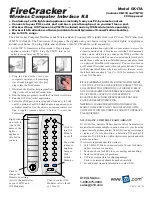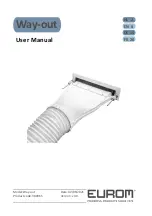
Section 3: Operating Instructions
STH1590 Spike Tooth Harrow 322-314M
5/9/19
13
2.
Limit transport speed to 20 mph. Transport only with
a tractor of sufficient size and horsepower.
3.
When traveling on roadways, transport in such a way
that faster moving vehicles may pass you safely.
4.
Shift tractor to a lower gear when traveling over rough
or hilly terrain.
Out-of-Field Inspection
Make the following inspections with harrow attached to a
tractor:
1.
Inspect tractor safety equipment to make sure it is in
good working condition.
2.
Inspect harrow for loose bolts and nuts. Tighten all
loose bolts and nuts as indicated in the
“Torque
Values Chart”
3.
Carefully raise and lower implement to ensure
drawbar, tires, and other equipment on the tractor do
not contact harrow frame.
4.
Check for and remove foreign objects wrapped
around the spike teeth and frame. Block harrow up
before removing objects.
5.
Check for missing, bent, broken, and worn spike
teeth. Replace spike teeth as required. Refer to
“Spike Tooth Replacement” on page 15.
6.
Verify harrow is level from left to right and front to
back. See "Lower 3-Point Arm Leveling" and “Center
3-Point Link Leveling” on page 10.
In-Field Inspection
Do not harrow in wet conditions. Wet material will build up
causing the harrow to not be as effective.
1.
Thoroughly inspect area to be harrowed for ditches,
drop-offs, stumps, post, rocks, and other unforeseen
objects that the harrow or tractor can snag on or hit.
Mark all potential hazards before working the area.
2.
Verify harrow is set at the correct working height. See
“Hitch Height & Chain Adjustment” on page 11.
3.
After the first 50 feet, stop and check to see that the
harrow is adjusted properly.
4.
Periodically turn tractor off, remove switch key, and
check for foreign objects wrapped around the spike
teeth and frame. Block harrow up before removing
objects.
5.
Frequently inspect the Spike Tooth Harrow for loose
bolts and nuts. Tighten all loose hardware as
indicated in the
“Torque Values Chart”
Field Uses
•
Firming Seedbeds
Most seedbeds are too loose and fluffy, Research
shows that by firming the seedbed, planting depth can
be better controlled resulting in huge increases (up to
54%) in germination rates. A firm seedbed also gives
better seed/soil contact for proper germination.
•
Leveling Soil
Eliminates troublesome ridges left by some tillage
tools and helps provide consistent planting depth
across the width of the drill, seeder, or planter.
•
Spreads Residue
This harrow handles large amounts of residue while
spreading it to manageable levels to allow tillage and
planting tools to do their job without the plugging
associated with heavy residue. It is a must-have tool
for processing no-till residue.
•
Breaking-up Residue
This harrow pulled 7 to 10 MPH on a hot, dry day will
shatter residue, turning it into mulch.
•
Conserving Moisture
Harrowing behind a primary tillage tool helps seal the
open soil and lowers the evaporation rate of moisture
in the freshly broken soil. Also, harrowing soil that has
crusted, breaks the capillary action that releases
moisture out of the soil.
•
Controls Sprouting of Volunteer and Cheat
Dry years delay sprouting of volunteer. By stirring the
soil with the harrow, the dormant seed contacts the
moist soil and sprouts prior to planting season. This
allows time to control the volunteer and cheat before
planting a new crop.
•
Incorporates herbicides
Preplant herbicides can be incorporated as deeply or
shallow as desired.
•
Covers Broadcast Seed
Wheat pasture and cover crops can be planted
inexpensively by spreading the seed with a fertilizer
spreader and covering it with the harrow.
•
Decreases Chemical Usage
Harrowing pulls out small weeds and volunteer,
uncovers overwinter insects to expose them to the
elements for fewer insects problems and firms the soil
to speed germination of weed and volunteer seed so
they can be destroyed prior to planting.
•
Good for Alfalfa Fields
Makes a perfect alfalfa seedbed. Use on existing
alfalfa fields before spring to level the ground, control
gopher mounds and to pull out small weeds. It also
aerates the soil for root/oxygen exchange, breaks up,
and spreads clumps of old residue.
•
Good for Grasslands
Grooms grass plants, knocks down gopher mounds
and pulls out small weeds.










































